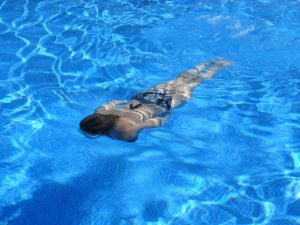Exercising With IBD
Exercising if important for everyone. If you have IBD there may be a few extra things to consider when exercising with IBD.
Let’s look into potential exercises that you may be able to do while in each stage of your healing. Please be aware that these are only suggestions, and you should only do what feels right for your body.
There are three phases of healing that we will discuss. Each phase is determined by symptoms present.
- Phase-1: active symptoms present
- Movement recommended: stretching, light exercise, easy walking, exercise in bed
- Phase-2: symptoms are improving
- Movement recommended: walking, yoga, swimming, light weight training
- Phase-3: remission
- Movement recommended: wider variety of exercises including weight lifting and running
Many people in an IBD flare may find exercising to be difficult. They may find that it could worsen, or increase their symptoms. In my some case, it has caused abdominal pain and nausea.
So how can someone with IBD find balance when adding movement into their lifestyle?
Below we will discuss further how someone in each phase of healing could add movement to their life.
The Benefits of Exercise
It is well known that exercise can help people manage stress. Many people with IBD believe that their symptoms are triggered by stress. So, learning to manage stress can be an important aspect of managing IBD long term.
Exercise helps improve mental health by releasing endorphins known as ‘happy hormones’ into the body. IBD can take a serious toll on our mental health. So, finding a tangible way to release happy hormones can be crucial to feeling better.
Many patients with IBD may also be managing depression and anxiety issues. Exercise is a healthy coping mechanism for these issues.
Exercising can also make you feel empowered and strong. It will increase your strength, and make you feel good about yourself.
Movement can also reverse muscular weakness. If you have experienced a severe flare, you may have lost a lot of weight. In this case, it is possible your body might have used your muscles as an energy source. This can leave you feeling weak and tired.

Exercise may also help with bone weakness. Due to the malabsorption of calcium, many people with IBD are at higher risk for osteoporosis. Incorporating exercise into your routine may help reduce your risk.
Some research shows that certain levels of exercise may decrease IBD disease activity. So, once you are in remission, daily movement and exercise may help you stay in remission for longer.
Walking, and swimming have both been shown to reduce inflammation levels in the body. Especially in patients with mild to moderate IBD symptoms.
Stage 1- Exercise While Experiencing Severe Symptoms
There is no doubt that exercise is good for us, but those with IBD symptoms may find exercising difficult. You may need to take it slow and you will have to listen to your own body’s needs. Begin with gentle movement to gain confidence and strength. Some may find aggressive or jostling movement uncomfortable when experiencing a flare.
If you are experiencing a flare, it may be better to focus on rest and small movements instead of traditional exercise. Once your symptoms decrease, it may be easier to add more exercise into your life.
Exercise in this stage may not look like traditional exercise. Instead, it may look more like everyday tasks, or simple movements. These simple movements could include:
- Walking to your car
- Standing at your job
- Preparing meals for yourself
- Looking after yourself and family
Try to move as much as feels good for you. Focus on soft, easy movements.

If you find yourself bed ridden, or needing to lay down a lot, exercising with IBD is still possible.
Consider exercising while in bed. You could try lifting some 1lb weights with your arms. Or moving your legs, doing an ‘air bicycle’ while lying down. Stretching while lying in bed is a great bexercise (bed-exercise).
These small movements can help with blood circulation in your legs, and may even prevent further muscle wasting.
Qi-Gong may be something that you want to try. It is a set of simple movements that focus on the breath. Try it once and see how you feel!
You may want to try incorporating a short walk into your day. Especially if the walk gets your out of the house and outside. Being outside can do wonders for your mood. It may improve your mental health, and general wellbeing.
Even if all you can manage is to walk to a nearby bench and sit and have a rest. Getting outside is sure to make you feel better.
Be sure to take as many breaks as required. Don’t push yourself too hard, and instead focus on movement that feels good. Remember that any small amount of movement is better than staying completely stationary.
Stage 2- Exercise While Your Symptoms are Improving

When you are exercising with IBD and your symptoms are better, you may feel able to incorporate more movement into your lifestyle. Adding exercises such as yoga or Pilates could be a great way to start.
I enjoy restorative or Yin yoga. The slow movements of these styles of yoga help me connect with my body, and feel good about myself.
To do yoga in the comfort of my own home I use the Down Dog app. I like it because I have access to my own toilet, can pause whenever needed, and can practice for as long or short as I want.
Walking, especially outside may also be beneficial at this stage. Go for a short walk with a loved one, or your pet. There are so many benefits of going outside:
- Getting natural vitamin D
- Smelling fresh air
- Seeing the many wonders of the natural world
- Improve your wellbeing in general
- Having a connection to your community or nature
You may even find some gentle weightlifting beneficial. It could help you to rebuild muscle that you may have lost in a flare. It can also make you feel more capable, and strong.
Stage 3- Exercise in Remission
Exercising with IBD that is in remission may be much easier than while you’re in the healing stages.
Once you are in remission, you may be able to resume your normal exercise routine.
Going for a run, lifting weights, or an extended walk may even help you stay in remission for longer.
Continue to listen to your body, and always give yourself enough rest.
Finding Balance
It has been shown that moderate movement and exercise can reduce inflammatory markers (source). Although intense exercise in IBD patients produces results that are less clear.
In my experience when I am in an IBD flare, and I have to run or jump, I have to immediately run to the toilet for a BM. When my symptoms are in remission, this does not happen to me.
Remember to always to listen your body, and learn what your own personal body is capable of during a flare and in remission.
Those recovering from surgery need to take extra care. They may need to speak to their doctor before doing any exercise.
As long as the movement you are doing feels good to you, there can be no downside to adding gentle exercise into your life. Start slow, and be gentle on your body. Take as much rest as you need; but be consistent with your routine. And keep going!
And most importantly, remember that exercising with IBD can be fun and empowering!
